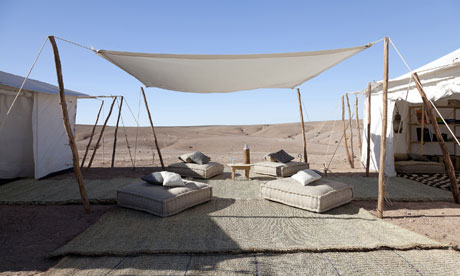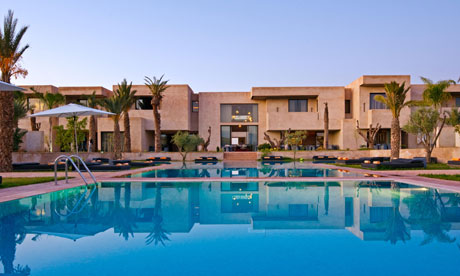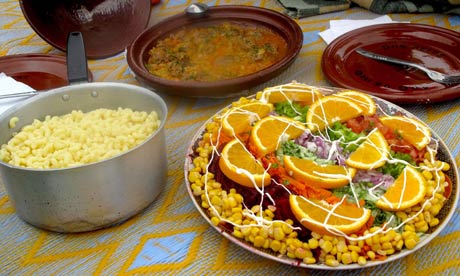From luxury desert camps and riad hotels to Atlas mountains walks and cooking lessons in the souks of Marrakech, we round up the best new holidays in Morocco
Nomadic beach retreat, Atlantic coast
A new trip combines the best elements of different holidays – a pinch of city break, a dash of fitness retreat, a soupcon of beach-bumming – to make a very appealing one. It begins and ends in a boutique riad in Marrakech, with spa treatments and delicious dinners. There's time for lunch in Essaouira and a night in a coastal village villa before the retreat begins in earnest. Each day, early-morning meditation is followed by four hours of walking along secluded beaches, then a luxury camp is set up while you enjoy an afternoon of yoga, reiki, swimming and sunbathing. Drinks are served at sunset and dinner is eaten around the campfire to the sound of tribal singing. The camp moves along the coast each day, with camels carrying everything – and you, if you get tired.
• £1,150pp for seven days including two nights at a riad, one at a villa and three at a luxury beach camp, all food and drink, hammam, scrubs and massages; and five days of reiki, yoga and meditation. The first trip starts 5 July, +212 6 6121 5062, moroccoretreats.com
Scarabeo Camp, Agafay
Camp Bling (camp-bling.com) is a new website bringing together the most luxurious campsites around the world – it's not just glamping, it's camp-bling, geddit? There are floating lodges in Cambodia, a luxury Galapagos safari site, a New Zealand campsite only accessible by helicopter, and now Scarabeo Camp, a nomadic encampment in Morocco. Eventually there will be four bivouacs across the country but the first to open is the Stone Camp, based in the desert of Agafay, around 40km from Marrakech. The camp moves location according to the season, but there are always views of the desert and the Atlas mountains beyond. Fresh bread is baked daily in a traditional earth oven.
• From €155 half-board for two people in a luxury tent
Sahara Safari Camp, Draa Valley
A new luxury tented wilderness camp, Sahara Safari Camp, opened in February near Zagora and Tagounite, south Morocco, and has now added some budget tents. They still contain proper beds and duvets, and each one has a private bathroom tent a few metres away. The camp has excellent eco credentials: bio-loos, solar lighting, local produce and partnerships with the tribal community to help minimise impact on the land.
• From £30pp pn for two people and a budget tent, including dinner and soft drinks, specialistmorocco.com
Hotels and riads
The Sirayane hotel in Marrakech
Marrakech
New ones to watch include the Sirayane hotel (doubles from around £120 a night, uk.sirayane.com), in the newly-hip area of Hivernage and the Route D'Amizmiz, designed in a simple style by architect Imaad Rahmouni, with an outdoor swimming pool facing the mountains and a small but stylish spa, plus an hourly free shuttle bus into the medina, around 10 minutes away. The Selman Marrakech (opening offer: around £290 B&B a night, selman-marrakech.com), a glamourous country club-style estate which opened this month, is owned and run by a Moroccan family and home to 16 Arabian horses. Ten are thoroughbreds and not for riding – they're more of a living art installation, roaming the 15-acre grounds – but the remaining six horses can be hired for trekking.
L'iglesia, El Jadida
Boutique Souk, the Morocco travel concierge service, is launching a new property in El Jadida this month. L'iglesia is a converted 16th-century Spanish church, now decorated in a 1940s/50s style, overlooking the sea. A separate wing of the property is housed in the old US consulate, which dates from the period of Portuguese occupation. El Jadida is a relaxed port town on the Atlantic coast, 60 miles south of Casablanca, with long beaches and a Unesco-recognised old town.
• From around £98 a room, boutiquesouk.com
Number Thirty, Essaouira
This quirky townhouse, billed as "Essaouira meets Brighton", is ideal for self-caterers who are looking for something a little different. There are plain walls, splashes of bright colour and retro fabrics – and not a traditional rug or tile in sight. It's in a quiet street in central Essaouira, an easy walk from the beach and restaurants, and has a roof terrace for sunbathing.
• From £100 a night, sleeps six, book through i-escape.com
Temple des Arts, Ouarzazate
Ouarzazate, a Berber city in south‑central Morocco, is a good base for expeditions into the Drâa Valley and the Sahara. The Temple des Artes, a seven-room luxury guesthouse, opened there last year. It is owned by a Moroccan film producer and is a celebration of cinema, with movie-themed suites and brilliantly ostentatious decor. The Atlas Film Studios, among the largest movie studios in the world, are just five miles down the road. They are well worth a visit for the strange site of old movie sets decaying under the desert sun.
• From around £105 a night, templedesarts-ouarzazate.com
Chez Max, Tagadert
This new earth house has been built in the Berber hamlet style, around central courtyards, in a sleepy village near Marrakech. There are six airy rooms and plenty of nooks and crannies, terraces and balconies for reading and relaxing, plus gardens and a swimming pool, and staff to do all the cooking.
• Five nights from £672pp B&B, including flights from London, lawrenceofmorocco.com
Activities
Walking week, Bougmez Valley
KE Adventure Travel has a new easy walking holiday in the Bougmez Valley, a lesser-trodden area of the Atlas mountains. The trip is based at the Touda Ecolodge in the village of Zawyat Oulmzi. Daily guided walks may take you to Lake Izourar in an ancient glacial valley, Ait Ourit, a peak with magnificent views, or to the market town of Tabant.
• £545 for eight days, excludes flights but includes transfers from Marrakech and all meals, departures 1 July, 9 September and 21 October, keadventure.com
History walk, Atlas mountains
Walks Worldwide's new Morocco trip, Raiders of the Lost Kasbah, follows the old caravan trade route across the Tizi n'Telouet pass, stopping at famous fortresses and fortified towns. Accommodation is mainly basic hostels with a night's camping, plus a couple of nights in a three-star in Marrakech.
• Eight days from £475pp, excluding flights, walksworldwide.com
Horse riding, Diabat
Explore the deserted beaches, fishing villages and argan forests south of Essaouira on horseback. You'll ride alongside goat herders, spot turtles and visit argan oil producers. Three nights are spent in a boutique hotel and three in a Berber tent, and the trip is suitable for all levels of experience.
• Seven days from £780pp, excluding flights, golearnto.com
Family holiday, multi-location
Time in Fes and Marrakech will appeal to the grown-ups on this new family holiday, while kids will be happiest in the mountains searching for Barbary apes, discovering dinosaur footprints, playing traditional Berber games and camping under the stars. Accommodation is a mix of hotels, village houses and basic tents.
• 15 days from £799 adults and £732 children excluding flights, explore.co.uk
Foodie
Tagine cookery class, Marrakech
Tagine cookery class, Marrakech
Urban Adventures has launched short tours in more than 80 cities around the world, where locals take visitors off the beaten track for a few hours. On the Tagine Cookery Class you have a short Arabic lesson to learn the words for key ingredients, go to the souk to shop for fresh produce, have a hands-on cookery lesson, then eat your salads, tagines and couscous for lunch.
• £36 for a four-hour class, urbanadventures.com
Berber lunch, Imlil
The Atlas village of Imlil is the centre of Moroccan mountain tourism and the starting point of many treks. Fleewinter's new day trek is designed to get people into the mountains for a taste of real village life. The highlight is lunch with a Berber family, overlooking one of the valleys. Mules will carry your bags and children.
• Prices vary depending on size of the group, fleewinter.co.uk
Culinary tour, multi-location
Trip Feast specialises in cultural tours with a culinary slant. On the new Exotic Flavours of Morocco trip, you'll make bread and other Fassi specialities in Fez and sample wine in Meknes. You'll meet olive growers and honey producers in rural villages on the way to Marrakech, where you'll go spice shopping, have cookery lessons, sample street food and eat in a hidden palace restaurant. Accommodation is in four-star riads and kasbahs.
• £1,295pp for eight days excluding flights, or £1,595 with flights, including breakfast and some other meals, departing 10 November or 23 March, tripfeast.com.
morocco culture,moroccan food,morocco food,moroccan cuisine,morocco beaches,moroccan meal,beaches in morocco,moroccan culture,hercules cave,hercules cave morocco

















